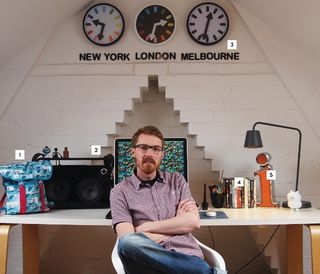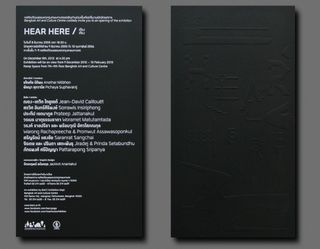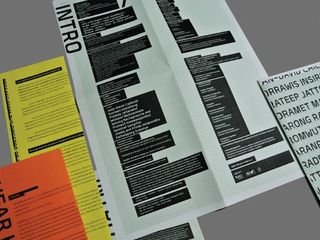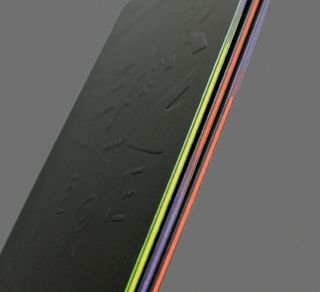The typographic revolution
Hubert Jocham explores how the unique appeal of display typography is bringing graphic designers and type designers closer together
Display fonts enjoy a unique position at the cross-section between graphic design and type design. The relative luxury of designing characters to be used at scale – and all the fine, beautiful detail that this enables – is uniquely rewarding for any designer with a passion for the style and form of individual letters.
What’s more, display typography is now entering a particularly exciting period in its development, and not just for type designers. The discipline is becoming increasingly accessible and rewarding for graphic designers and studios alike to indulge in – whether creating a bespoke font to add a unique, stylish twist to a project, or designing a fully-operational typeface to take to market.
Of course, a traditional background in typography will inevitably help a designer create strong characters. But classic type design doesn’t always play a terribly big role in mainstream education, and creatives will often start out studying graphic design before falling in love with the process of crafting type specifically.
For many type designers, the ultimate challenge is to create a brilliant typeface for text. In a lot of ways, it’s the opposite of designing display type: doing so presents the unusual task of creating something at a large scale that will only ever live in small sizes. The queen of this was always the old-style serif, and for many designers it’s a real passion and pleasure to work on that style of type.
For the most part, text faces still remain the domain of traditional type designers. But display type is becoming a more level playing field, a trend that began with the advent of more easily accessible type design software in the 80s and 90s. This simplified the creation of fonts greatly, and the market quickly filled up with interesting, but fairly useless stuff. Looking back at some of those typefaces now – and especially the display typefaces – it now seems like a playground almost without boundaries. It was in the wake of this period that display type lost some of its good reputation.
But while one could easily call this experimental period a curse, it was also a blessing. As the overall quantity of typefaces increased, the number of good, well-thought- out typefaces also increased proportionately – and more importantly, it also enhanced the overall awareness of font design in general.
Complete control
This process of digitisation ultimately changed the role of the type designer, too. Rather like the Renaissance mastermind, he or she could now be in charge of the entire production process, eliminating the need for a traditional foundry’s extensive in-house resources. Ale Paul, Underware, Christian Schwartz, Ludwig bele and many others now operate their own foundries, often independent from the big networks. They sell high-quality, modern typefaces that are created with a clear purpose and implementation in mind.
In some cases, smaller foundries will also go to more elaborate lengths to showcase their wares, compared to vast global powerhouses such as Monotype or FontShop International. By operating as a design studio as well as a type foundry, Delaware-based House Industries is a prime example of how sound graphic design principles can be employed in the marketing of typefaces as well as their creation. Its renowned Eames family has famously spawned its own series of desirable ‘objects’, from bespoke wooden packaging to collectable alphabet blocks – and its promotional activities have even stretched to chairs and pillows.

During its 30-year history, House has seen its typefaces used across everything from billboards to greetings cards, album artwork to TV and film. Recently, however, it has reached beyond its own type library and presented the display version of the timeworn classic Caslon as a striking typographic poster in several colourways – 2011’s red version sold out in an hour, and was followed by a green and most recently a brown variety.
“Mix the legibility of William Caslon’s nearly three-century-old typographic standard with a few raucous parties at Timothy Leary’s house,” grins House type designer Ken Barber, conspiratorially, “and one might find the impetus behind Ed Benguiat’s display-oriented version of the venerable typeface.”
House Industries is an example of a foundry that capably straddles the boundary between type and graphic design. On the flip side, many design studios can be found investing the time and energy to create bespoke type for projects: notably Non- Format. Renowned for its distinctive, highly stylised and sometimes proudly illegible twist on typographic design, the popular studio – run by co-founders Jon Forss and Kjell Ekhorn – puts a fresh twist on each project as required.
“Display type is really all about expression,” says Forss. “It’s made to be used large, so it doesn’t have to bother with the tedium of being set in columns of small text. It can sing and shout and jump about.”
Forss is particularly passionate about how display type can be more indifferent to legibility than its text face counterparts: “It was created for writing slogans such as ‘You read best what you read most’, and ‘Don’t mistake legibility for communication’. Even at its most elegant – Fabien Baron’s editorial work, for example – it can express a great deal of emotion,” he goes on. “If text weights are the head, display type is the heart. Anyone who gets a thrill from thumbing through a Letraset catalogue knows what I’m talking about.”
To fellow designers who might be looking to dip their toes into the waters of typeface design, Forss says success lies in the right mix of iconoclasm, analysis and experimentation. “When it comes to breaking the rules,” he reflects, “there’s a lot to be said for ignorance. But I reckon the more type you look at and the more you pay attention to typography in all its forms, the easier it is to see what’s missing; what needs to be done next. My advice to anyone embarking on any kind of creative endeavour is simply to seek out two things that don’t belong together and then bash them into each other until they create something new.”
Like Non-Format, freelance designer Anthony Neil Dart tackles display typography as part of a broader creative skillset. Dart works across numerous creative fields – graphic design, illustration and photography, animation, motion design and direction. Having such a multidisciplinary approach, he sees no reason to diff erentiate between type and image. They’re both communication tools, and as such, should both be a part of every designer’s toolkit.

“I think any designer who is serious about design should take type seriously, too – display type can be seriously playful,” argues Dart. “For me, personally, there’s less and less of a distinction between type and image. A few years ago I found myself almost thinking about them separately; now, they’re more like two sides of the same coin.”
Cottage industry
Dart draws attention to the proliferation of smaller foundries and typeface suppliers in the modern-day market, such as Ten Dollar Fonts, Hello Font and Handmade Fonts. “As with any technology, as software becomes cheaper and easier to use, type design will develop a far broader audience and user base than ever before,” he argues. “I think this trend will continue to accelerate.”
Jon Forss identifies a particular gravitation towards gothic revivalism within display type in particular: “This seems to come from the neoclassical strand of the postmodernism revival we’re going through,” he suggests. “If you see a nice marble background, chances are a chisel serif is lurking somewhere nearby.”
But his best guess is that the future holds a new period of disruption – a “huge wave of work that challenges the old order, and makes a few enemies along the way.” He cites the examples of Terry Jones’ handmade headlines at i-D in the 80s, and perhaps even David Carson’s grunge approach in the 90s, as equivalent touchpoints.
“The Carson Ray Gun era was all about the cult of the ugly – consumer font software wasn’t that widespread, but those that had it were churning out all manner of fonts, from the earnestly postmodern, such as migr, to the blatantly bastardised – Barnbrook, Kisman, van Blokland and so on,” Forss recalls nostalgically.

“The 2000s were the era of maximalism and the neo-baroque: take an existing typeface and add decoration,” he continues. “Another great period for expression. The latter half of the decade saw a swing in the other direction: the decoration was stripped away, and headline typefaces were pumped up on steroids.”
Finally Forss brings his historical analysis of typefaces right back up to the present day, and maybe beyond: “Most of those superbolds are now being transformed into what I recently saw termed as pictogram typefaces,” he says. “A hybrid of the geometric typefaces of recent years, along with more decorative forms. Many foundries now sell fonts with very simple geometric bones, but which carry the DNA of a more exuberant, decorative period.”
Dart’s message is one of optimism: he believes that all designers should be looking to create their own display type as standard, and continued advances in technology mean there’s no excuse not to experiment. “Great display typography has always been paramount for expressive design,” he insists. “With everything advancing at such a rapid pace, I find it hard to believe that this will change in any significant way. The tools and distribution will simply improve, which over time raises the overall standard.”
Collaboration, of course, is one viable option for graphic designers to translate conceptual letterforms into fully working typefaces, and there are few better examples of this process in action than HypeForType, a proudly collaborative foundry that throws open the field to graphic designers with an interest in type design, bridging the gap with professional type designers to create an entirely new fusion of disciplines.
Alex Haigh originally set up HypeForType after becoming disillusioned with what he believed were diluted, inferior, underdeveloped and technically flawed products elsewhere in the market – negative by-products of the increasing democratisation of the discipline. “I thought it would be a great idea if you could get these designers that everyone loves and looks up to, and make some of their work into a usable font,” he considers.
Font of knowledge
Non-Format is one of the studios within HFT’s ever-growing back catalogue, alongside designers such as Si Scott, Alex Trochut and Anthony Burrill, translated into working fonts by US-based type designer Dawn Lewandowski. Graphic designer Alexander Wright is one of the foundry’s latest crop of exclusive typeface designers for 2013, producing Alicia – an eye-catching geometric face based on simple graphic shapes. While Wright welcomes the increasing accessibility of the field, he also laments the somewhat inevitable drop in quality that comes from lower barriers to entry.
“With the introduction of computers, everybody has access to type design – whether they’ve received any formal training or not,” he says. “That inevitably results in some very poor type work. Even today, you see so many pieces out there with zero attention to the basics, with the kerning all over the place.”
While that might be the case, it also helps some genuinely groundbreaking creative work to punch through where it might not otherwise have surfaced in the past: “Technology has also broken down the limitations that typographers may have faced back in the day,” he points out.
Get the Creative Bloq Newsletter
Daily design news, reviews, how-tos and more, as picked by the editors.

Wright continues: “You see this amazing, mind-blowing work that would have never been possible with the few tools they had available then. I guess the key is really in creating a culture of good, correct use of typography among both designers and clients alike.”
Ultimately, just like text typefaces, today’s display typefaces are still required to fulfil a specific function. Besides the formal requirements, their main purpose is to create a strong atmosphere, a distinct voice for a specific usage – whether it’s selling a product or supporting a magazine’s brand.
It’s certainly true that display type is more glamorous, in many ways, than creating a typeface for text. This is not only because of the design task itself, but also because of its use in fashion or packaging design, for instance.
Type designers are pretty strange people for the most part. They tend to see everything in black and white. However, designing display typefaces can make you less serious, less sarcastic and ultimately less critical about contemporary typography. And that can only be a good thing.
Discover 85 amazing typography tutorials at our sister site, Creative Bloq.

Thank you for reading 5 articles this month* Join now for unlimited access
Enjoy your first month for just £1 / $1 / €1
*Read 5 free articles per month without a subscription

Join now for unlimited access
Try first month for just £1 / $1 / €1
The Creative Bloq team is made up of a group of design fans, and has changed and evolved since Creative Bloq began back in 2012. The current website team consists of eight full-time members of staff: Editor Georgia Coggan, Deputy Editor Rosie Hilder, Ecommerce Editor Beren Neale, Senior News Editor Daniel Piper, Editor, Digital Art and 3D Ian Dean, Tech Reviews Editor Erlingur Einarsson and Ecommerce Writer Beth Nicholls and Staff Writer Natalie Fear, as well as a roster of freelancers from around the world. The 3D World and ImagineFX magazine teams also pitch in, ensuring that content from 3D World and ImagineFX is represented on Creative Bloq.
